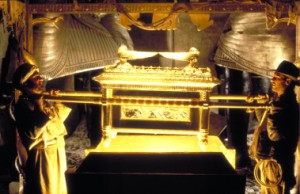
The Ancient Sacred Complex of Delphi
Delphi / Δελφοί
Delphi (or Δελφοί) was a religious center for the two millenia from 1600 BC until 395 AD. Diodorus Siculus wrote in the first century BC of a much earlier goat herder named Coretas, a man who lived in the area before 1600 BC. One of his goats fell into a crevasse in the ground and began behaving strangely. Coretas climbed down into the crevasse to rescue the animal, and found that he was filled with a divine presence. He could see out of the present into the past and the future.
Coretas told some of the nearby villagers about his experience. They started visiting the crevasse and experiencing the convulsions and inspired trances. Yes, sure, some villagers disappeared down into the crevasse in their frenzied state, but that's a risk that comes with theophanies!
Amazon
ASIN: 0691169845
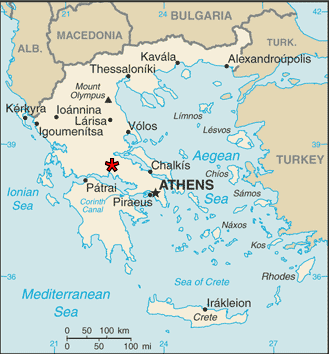
Delphi is northwest of Athens, about three hours journey by bus.
Delphi Becomes a Religious Center
By 1600 BC a shrine had been erected at the site. The shrine was initially dedicated to Gaia, the Mother Goddess of west Asia, according to Aeschylus in the prologue of his Eumenides.
Then the myth held that the office of Oracle was held by the goddesses Themis and Phoebe. Later, the site was believed to be sacred to Poseidon, the deity of earthquakes known as "Earth-Shaker". During the Greek Dark Ages (11th-9th century BC), the temple was turned over to Apollo. A modern interpretation holds that Apollo was a late addition to the Greek pantheon from Lydia, in today's Turkey, and that he was originally the Mesopotamian diety Aplu, an Akkadian name meaning "son".
When the more recent but still ancient Greek pantheism arose, Apollo was associated with the site. The Homeric Hymn to Pythian Apollo tells of Apollo first coming to Delphi in the shape of a dolphin carrying Cretan priests on his back. The Homeric name for the oracle is Πυθω or Pytho.
Delphi became the site of a major temple to Apollo and the Pythian Games, staged every four years starting in 586 BC.
Then there is the silly sounding deity Απόλλων Σμινθεύς, or Apollo Smintheus, Apollo Mouse-Killer. Mice aren't the top of the food chain, but they are a source of disease and so old Mouse-Killer gets credit for preventative medicine.
The Sacred Approach
The ancient Greeks did not simply place a temple where it was convenient or where real estate was easily available. Sacred sites were part of a larger landscape, and a visit started while you were still some distance away.
The ancient port of Kira, now a couple of kilometers from the center of the modern resort town of Itea, was the initial arrival point for a visitor in classic times.
Kira and Itea are visible along the coast in this picture, down the Pleistos Valley and well below the modern town just west of the ancient sacred complex.
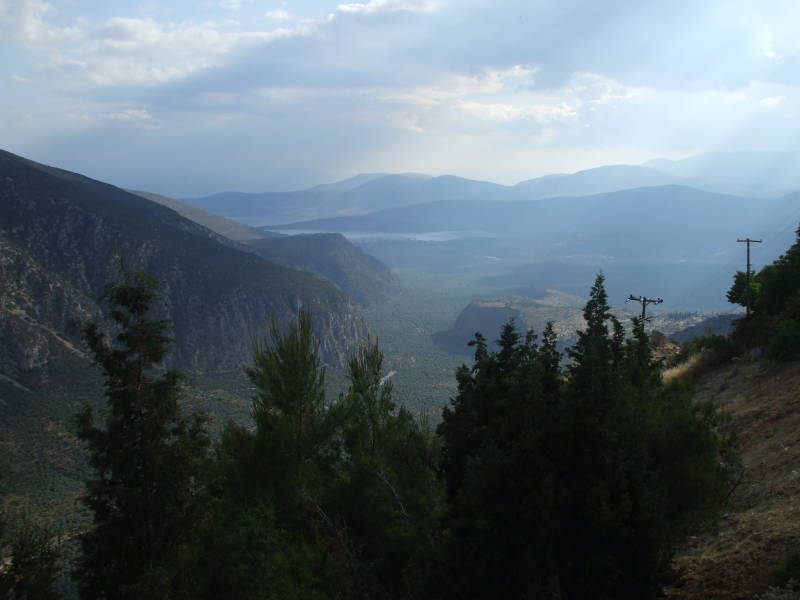
We're looking down the valley from Delphi, toward the coast of the Gulf of Korinth and the port of Kira.
The worshipper or supplicant would make their way up the Pleistos Valley from the port, a distance of about 18 kilometers, preparing themself as they moved into the sacred space.
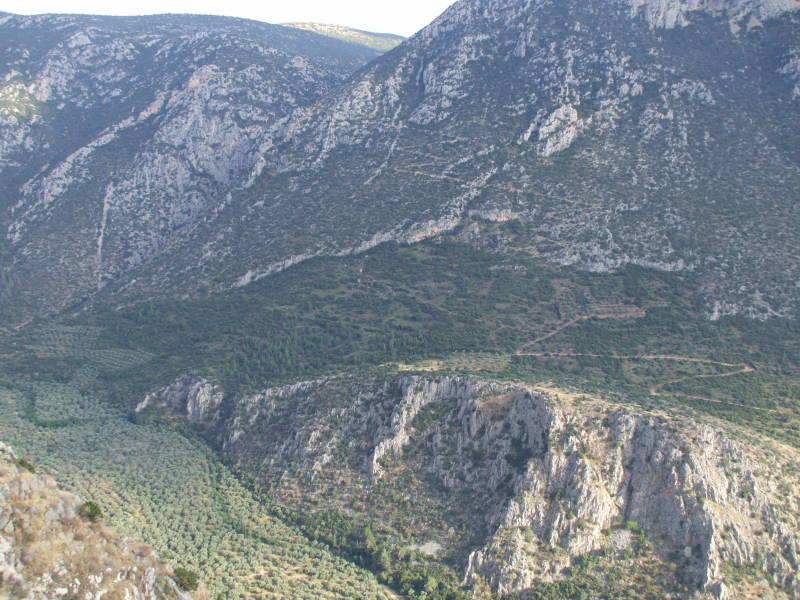
The worshipper or supplicant would approach the sacred complex of Delphi through the Pleistos Valley.
The valley now has a few unpaved lanes accessing the agricultural fields. The modern traveler follows a narrow highway leading through the narrow hillside town of Delphi and through the center of the ancient sacred complex.
The valley climbs further into the mountains to the northeast of Delphi. The road continues through Arahova, toward the main E75 highway running north from Athens along the east coast, through Lamia and Larisa toward Thessaloniki.
Arrival at Delphi
The ancient visitor would have continued to a point further up the valley from Delphi, then turned and approached the outlying precincts.
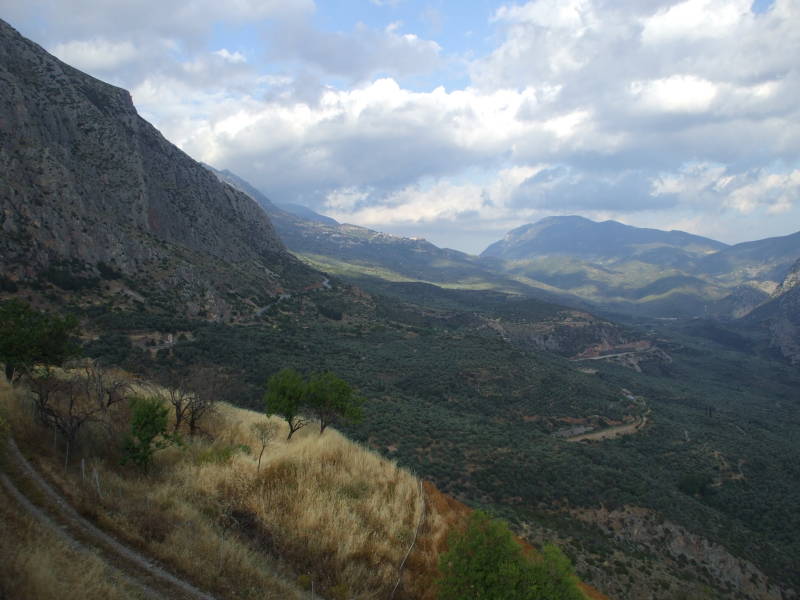
The Pleistos Valley leads further into the mountains above Delphi.
The ancient visitor would have entered Delphi by way of the Tholos at the sanctuary of Athena Pronaia, constructed 380-360 BC.
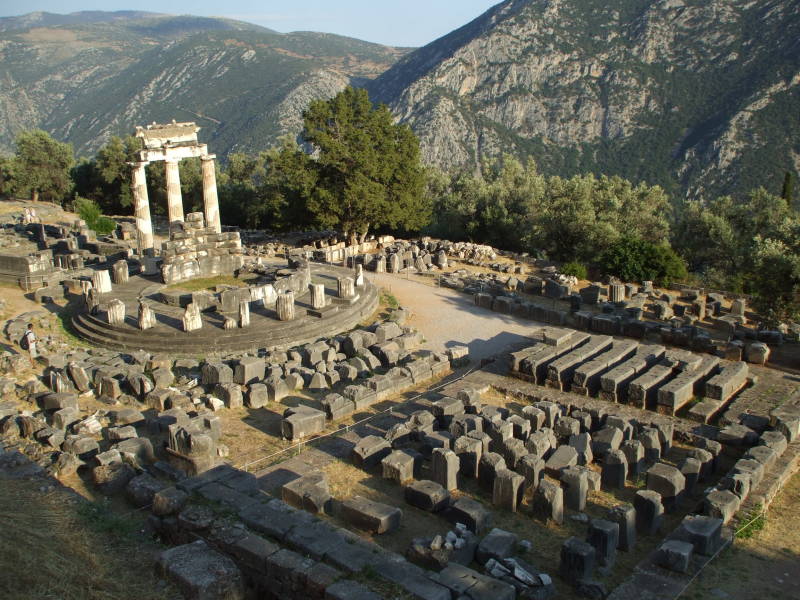
The Tholos at the sanctuary of Athena Pronaia was constructed in 380-360 BC.
The ruins to either side of the Tholos are treasuries built by different Greek cities and colonies to hold treasure and offerings they sent to the holy site.
One of these is the Treasury of Massalia, a Greek colony city now known as Marseille, in southeastern France.
The Tholos was a circular building of 20 Doric columns in a circle around 10 Corinthian columns. It is said to have been built by Theodorus the Phocian.

The Tholos was a circular building of 20 Doric columns in a circle around 10 Corinthian columns.
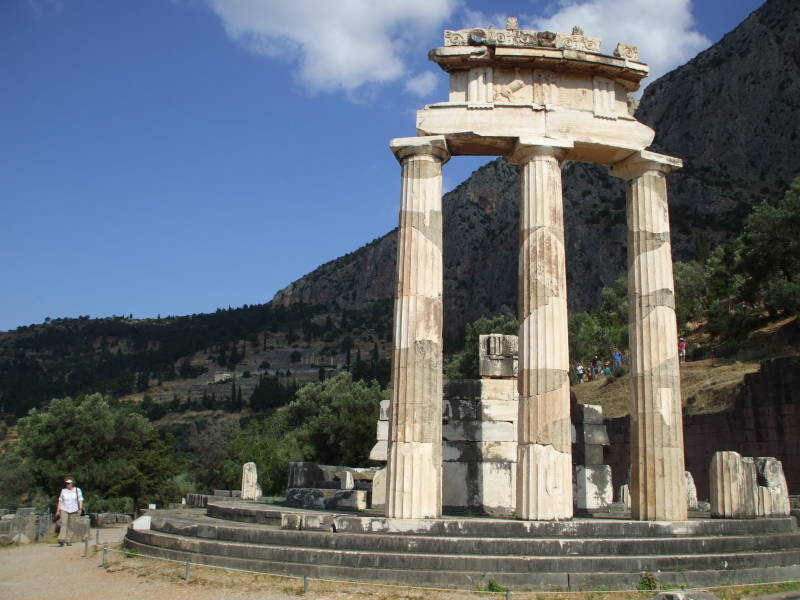
The temples of Delphi could be seen from the Tholos.
Here we are looking past the Tholos toward the main temple complex of Delphi.
Purification for Entry into Delphi
The visitors would purify themselves as they progressed toward the center of the holy complex. These are the gymnasium and its baths, near the Tholos.
These were originally built in the 4th Century BC, and were later rebuilt by the Romans.
The central frigidarium or cold bath was 9 meters in diameter and 1.8 meters deep.

Delphi's gymnasium and baths were located near the Tholos.
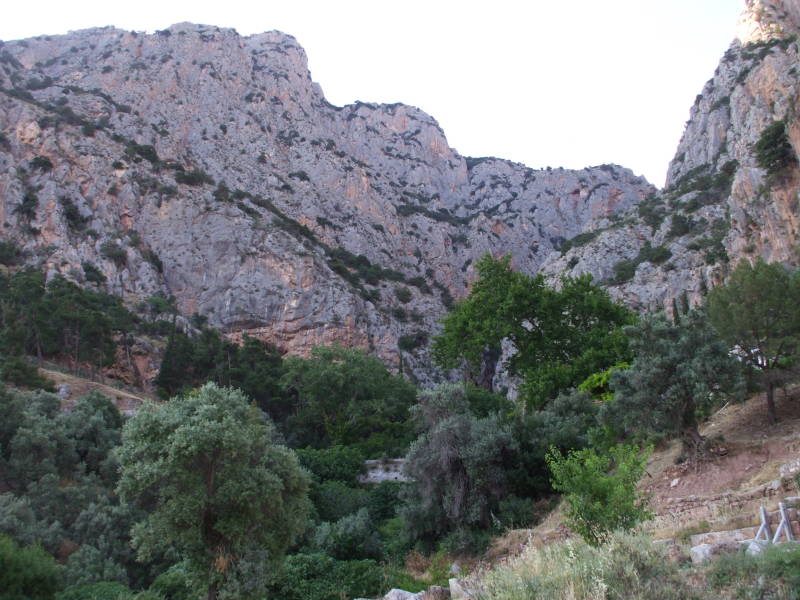
The source of the Castelian Spring is in the ravine of the Phaednades.
Looking the opposite direction, up the tall and steep slopes of the southern wall of the valley, we see a ravine separating the two Phaedriades, the two peaks overlooking Delphi.
Where the modern road crosses that ravine, as seen at right, you still find the spring of the Castalian Fountain. The area of the fountain itself tends to be blocked off because of falling rock.
The very recently excavated Castalian Bath is where all visitors to Delphi stopped to wash their hair. It is also where the Roman era poets paused to receive inspiration. This was believed to be the very spot where Apollo killed the monster, Python, and so it was especially sacred.
The Castalian Spring and sacred bathing for cleansing purposes goes back to Mother Goddess days, long before the Delphi of Classical Greek tradition.
What you see here is a 6th century BC marble-lined basin surrounded by benches.
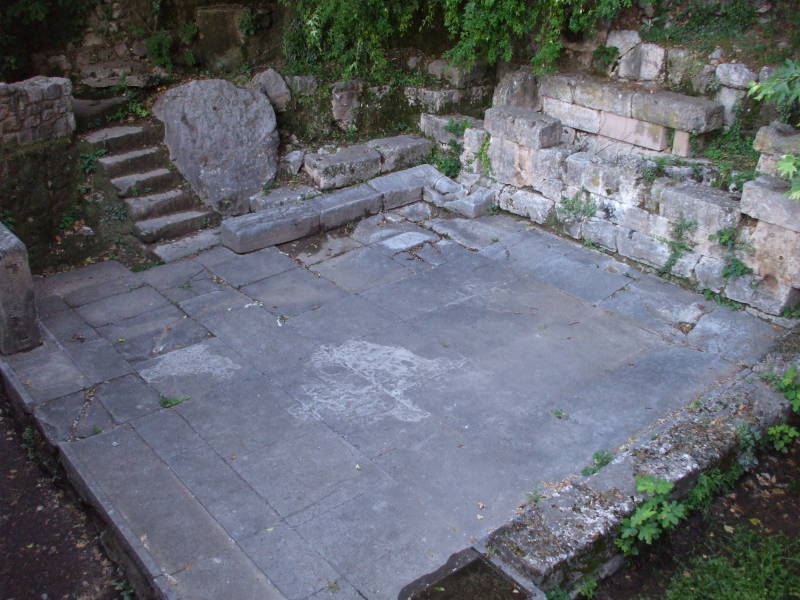
Visitors purified themselves at the Castelian Spring before entering the sacred precincts.
The Center of the Universe
In the background above we see the Athenian Treasury, but more on that in a bit.
Much more important is the Omphalos, quite literally the center of the universe to the Greeks. Really.
Omphalos means navel in Greek, so this is the navel or the center of the world. Supposedly Zeus sent a pair of eagles flying across the world from either side to meet at its center. Several places around the ancient Mediterranean claimed to be their meeting point, with stones erected to mark the true center. To the Greeks of that era, this was it.
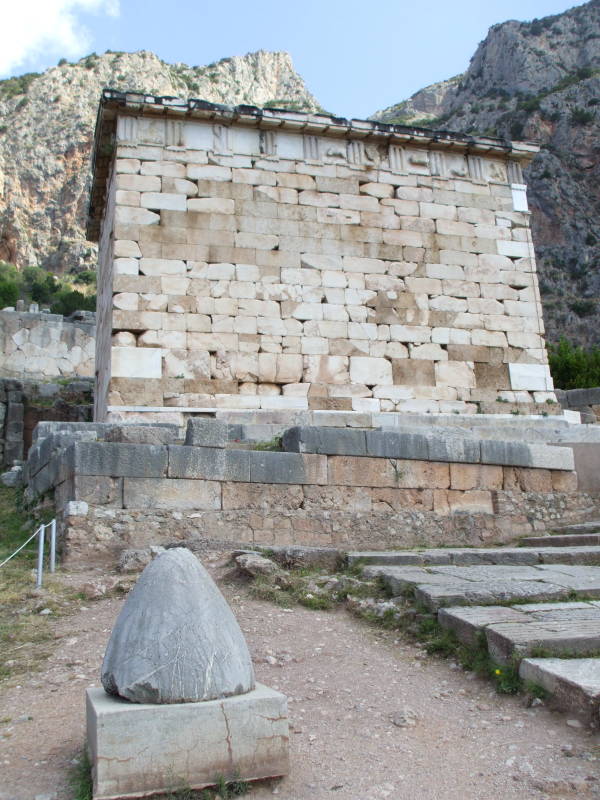
The Greeks believed that the Omphalos was the Center of the Universe. It's just below the Athenian Treasury.

The Omphalos, the Center of the Universe.
Just as there were multiple Omphalos locations, at this one there were several Omphalos stones. The museum at Delphi has one better meeting the ancient descriptions of a rock generally of this shape. It is of this general tapered or egg-like shape, but its surface is carved like a knotted net and it is hollow along its central axis.
The Omphalos stones were thought to provide direct communication with the gods. It has been suggested that the hollow Omphalos was used to channel the intoxicating gas breathed by the Oracle, in which case the center of the world was probably about 60 meters to the northwest, in the innermost chamber of the Temple of Apollo.
The Byzantine Emperor Theodosius I shut down oracular activity in 395 AD and subsequently the site was largely destroyed. That led to a Christian Omphalos being set up in Jerusalem, based on the medieval cosmology of Jerusalem being at least the spiritual and possibly the physical center of the world.
That Christian cosmology was based in turn on an earlier Jewish one calling Jerusalem the Navel of the World.
The Ark of the Covenant was kept in the Ark of the Temple in Jerusalem, where it rested on the Foundation Stone, the השתײה אבן (or Even haShetiya) marking the "navel of the world". This was the holiest location in Judaism, and Jewish prayer is performed facing toward the Foundation Stone. Going further back into tradition, this was the threshing floor (a large flat stone surface) that David purchased and offered sacrifices upon, and before that Abraham almost sacrified Isaac upon the same rock, and before that Noah, Cain and Abel, and even Adam himself offered sacrifies upon it.
The Jewish tradition did not date back to the time of the exodus out of Egypt. It began in Hellenistic times, when Greek culture was well established throughout the Levant. The Jewish people were very familiar with (and largely immersed within) Greek culture, and the Jewish tradition might have come directly from the Greek one.
The Temple Mount in Jerusalem is now topped by the Islamic shrine Masjid Qubbat As-Sakhrah or Dome of the Rock, also known as the Bait-ul-Muqaddas or the Noble Sanctuary, built in 689-691 CE. It was built around the exposed Foundation Stone, which Muslims also believe was the keeping place of the Ark of the Covenent, and more significantly to them, the location where the angel Gabriel took Muhammad to pray with Abraham, Moses, and Jesus, and where Gabriel took Muhammad to heaven.
The Oracle
Going back to Delphi and the earlier Greek tradition from which some of those ideas seem to have come, this is the Sybil Rock just below the Temple of Apollo.
The idea was that the god Apollo spoke through his Oracle, also known as the Pythia.

The Sybil Rock is just below the Temple of Apollo.

The Athenian Treasury.
The Pythia had to be a woman "of blameless life" chosen from the peasants of the area. She sat on a tripod over a crevice. Apollo was said to have killed and buried a mythic Python, really a dragon and not a large snake as the term now means. The temple was thought to be built over the buried dragon, or the chthonic Python in the parlance of their time.
A Temple of Apollo, built on the former home or temple of the monster or diety he killed. This is another case of a temple to a newer and superior god being built on top of a temple to an earlier and vanquished one.
The fumes rising from the decaying body of the Python would intoxicate the Oracle and put her into a trance in which Apollo possessed her.
The Oracle would then babble semi-coherently. The temple priests would "translate" her ravings into elegant hexameters.
Oracular activity continued until 395 AD, when Byzantine Emperor Theodosius I shut it down. The Oracle famously made one final pronouncement.
Tell the king; the fair wrought house has fallen.
No shelter has Apollo, nor sacred laurel leaves;
The fountains are now silent; the voice is stilled.
It is finished.
Theodosius I was dead within two years, and within 20 years the Western Roman Empire had finished falling to the barbarians (although the Eastern or Byzantine Empire lived on for almost another one thousand years).
The Athenian Treasury was built by that city-state in 480-490 BC to commemorate their victory at the Battle of Marathon.
The sacred processional Sacred Way leading to the Temple of Apollo was lined with these treasuries, built to commemorate their military victories and thank the Oracle for her cryptic advice and suggestions. For example, before the Battle Salamis the Oracle told the Athenians to trust their "wooden walls", which the Athenians interpreted to mean their naval fleet.
The city-states' treasuries housed offerings to Apollo, frequently a "tithe" or a cut of the spoils of victory.
These treasuries were, of course, an obvious target for sacking. Pillagers included Phillip of Macedon (father of Alexander the Great), the Celts, and the Roman Dictator Sulla.
A large theatre overlooks the processional way and the Temple of Apollo. The theatre could seat 5,000 spectators in 35 rows for the "mystery plays" re-enacting the struggle between Apollo and the Python. The first row of seats was reserved for the chief priest and other officials, plus whoever was the Jack Nicholson courtside figure of ancient Delphi.
Further up the slope is the stadium, although access that far up may be restricted to due to rock falls, reconstruction work, or the Greek penchant for arbitrary closings.
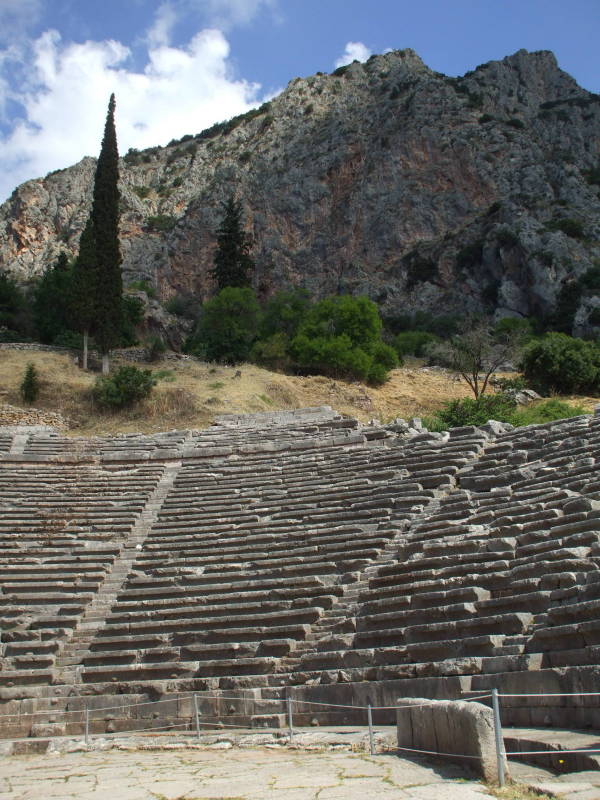
The Theatre in Delphi.
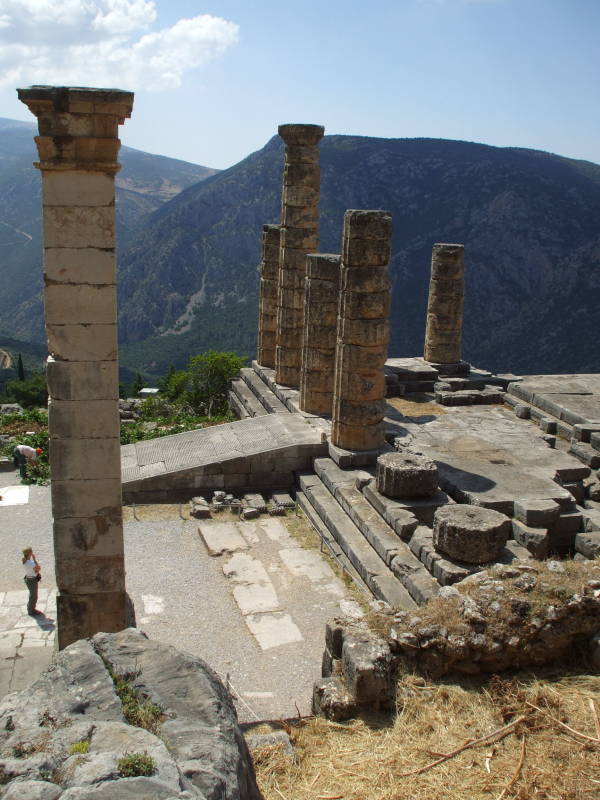
The entry to the Temple of Apollo in Delphi.
This is the entry to the Temple of Apollo. A large round base for a freestanding column, now empty, sits in front of the temple entrance.
That base once held a bronze column, at least as tall as the stone one seen here, in the shape of three intertwined serpents representing the Python killed by Apollo. Constantine the Great had it transported to his capital city of Constantinople, now known as İstanbul, to demonstrate his power as Byzantine Emperor. It still stands in the same location, where it used to be near Constantine's palace and now is just in front of the Blue Mosque or Sultan Ahmet Cami.
The temple famously bore a mysterious large letter E.
Epsilon can signify the number 5, if that helps...
It also had these three phrases:
Γνωθι
σεαυτόν
—
Gnōthi seautón —
Know thyself
Μηδέν
άγαν —
Mēdén ágan —
Nothing in excess
Εγγύα
πάρα
δ'ατη —
Engýa pára d'atē —
Make a pledge and mischief is nigh
The Oracle and the Ethylene
Here is the main temple in Delphi, what everything was building up to — the Temple of Apollo. There was a 7th century BC temple attributed to the architects Trophonios and Agamedes. That was destroyed by fire, and was replaced in the 6th century BC by a temple funded by the Alcmeonidae family of Athens. That one was destroyed by an earthquake in 373 BC, and replaced by what we see here, the third (so far as we know) temple completed in 330 BC.
The temple is described as a Doric building with a peristyle, 60.3 meters long by 23.8 meters wide, with columns 12 meters tall.
The front of the temple, its entrance, was at the far or left end in this view, the end toward the mountain.
For those allowed to enter the temple, the Sanctum Sanctorum, the Holiest of Holies, was at the far end, nearest the viewpoint in the pictures at right and below.


Ethylene: C2H4 or H2C=CH2
This was the adyton where the Pythia or the Oracle of Delphi sat on a tripod above a crevasse. The Oracle's seat in the adyton seems to have been around what appear to be some sagging floor panels toward the left of this picture.
Some recent archaeological and geological research suggest
that the Oracle's strange behavior may have been caused by
ethylene gas emitted from the crevasse below the temple.
The temple lies exactly on the intersection of two major
fault lines, one running north-south and the other east-west
and paralleling the Corinthian Gulf shoreline.
The bedrock is limestone rich in hydrocarbons and pitch.
Friction from fault movement would vaporize some of the
hydrocarbons, including ethylene, and drive them out
through small fissures.
Ethylene can cause mixed euphoria and frenzy followed by
little to no recollection of one's action or altered speech
during the period of intoxication.
See:
National Geographic News
14 Aug 2001
Scientific American
August 2003 [2003;289(2):66-73]
Erowid's report on this early ethylene use, referencing
Journal of Toxicology — Clinical Toxicology
[2002;40(2):189-196],
The New York Times [19 March 2002],
Nature [17 July 2001],
National Post [25 July 2000],
and Clinical Toxicology (Phila) [2007;45(1):85-89]
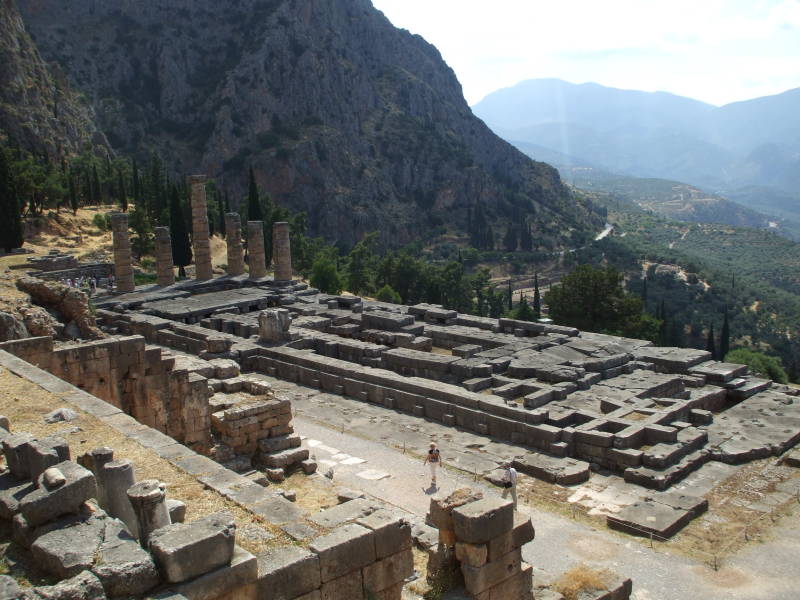
The Temple of Apollo in Delphi.

The location of the seat of the Oracle, in the Temple of Apollo in Delphi.
If you go to the south side of the Temple of Apollo, the long downhill face, toward the southwest corner (downhill and away from the entry end), you can spot this passageway leading back underneath the Oracle's seat!
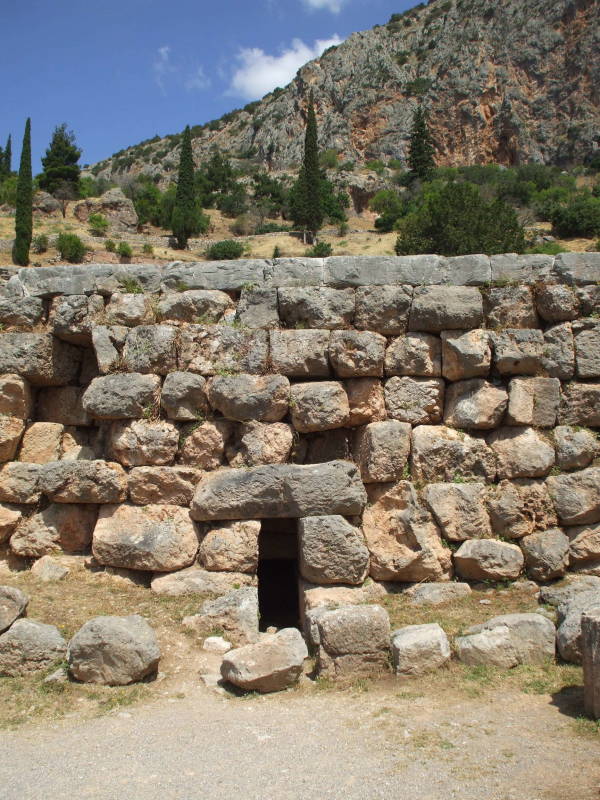
A passageway to the ethylene seep below the Temple of Apollo in Delphi.
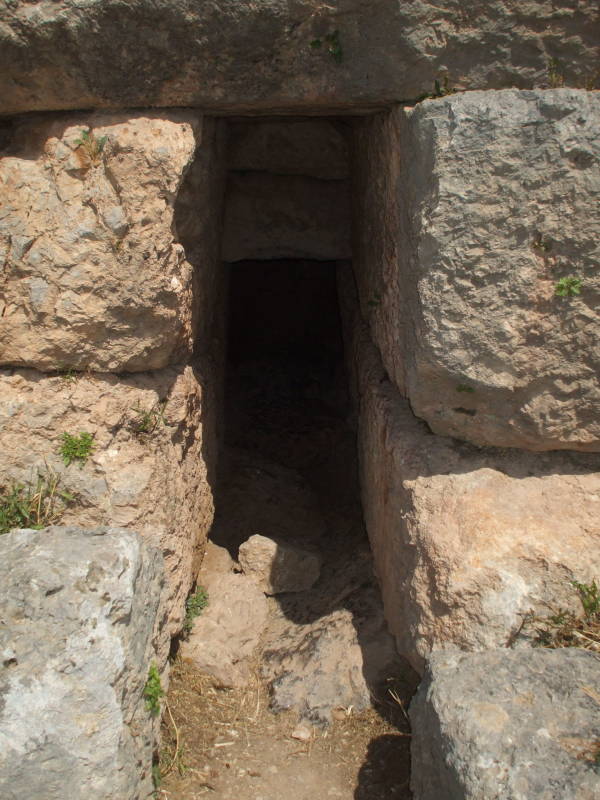
A passageway to the ethylene seep below the Temple of Apollo in Delphi.
Yes, there is just barely enough room to crawl back into this passageway leading underneath the Oracle's seat.
However, as far as I could tell, no ethylene was seeping into the passageway.
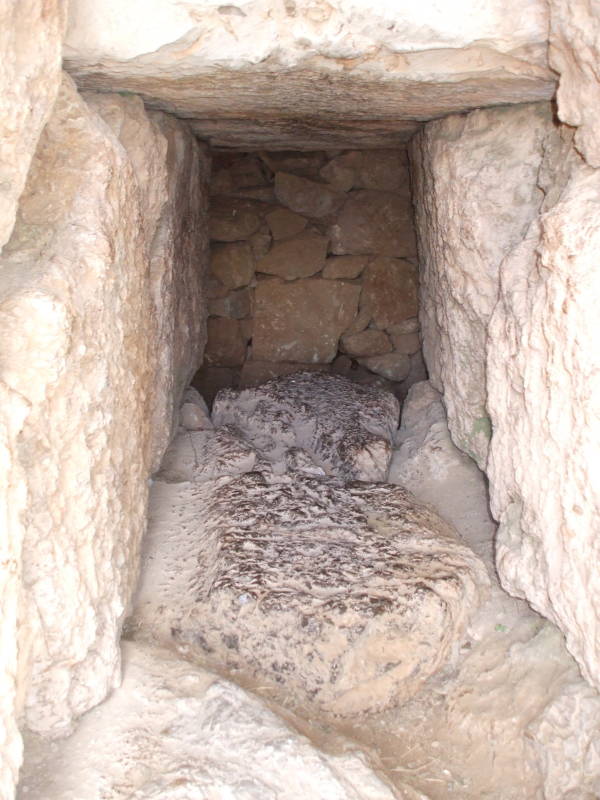
Inside the passageway to the ethylene seep below the Temple of Apollo in Delphi.
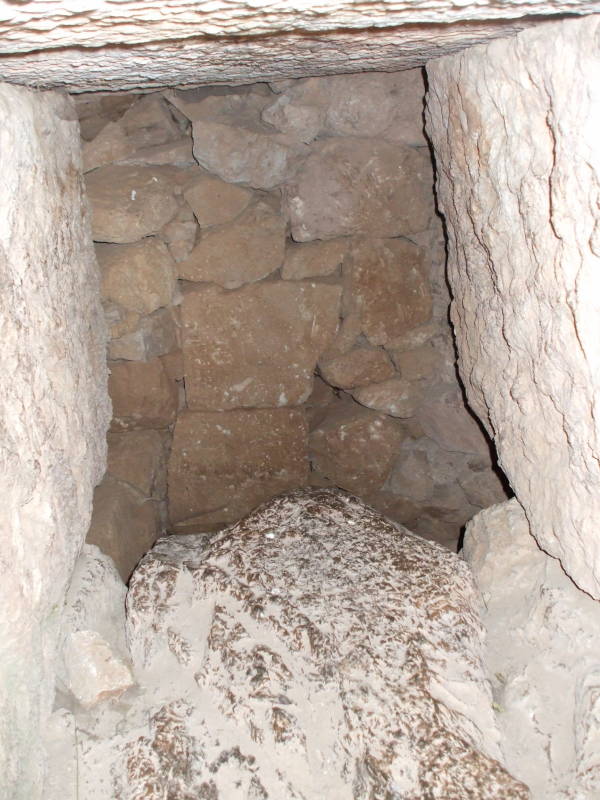
Inside the passageway to the ethylene seep below the Temple of Apollo in Delphi.
Or at least I had no visions. And, as far as I know, I did not babble incoherently.

Marble column at Delphi.
Check ferry schedules and buy tickets:
Practical Matters
The nearby modern town of Delphi is a nice base for your visit. Yes, you can do an all-day bus trip out of Athens, but you would be spending an awful lot of time in a bus and not really experiencing the place.
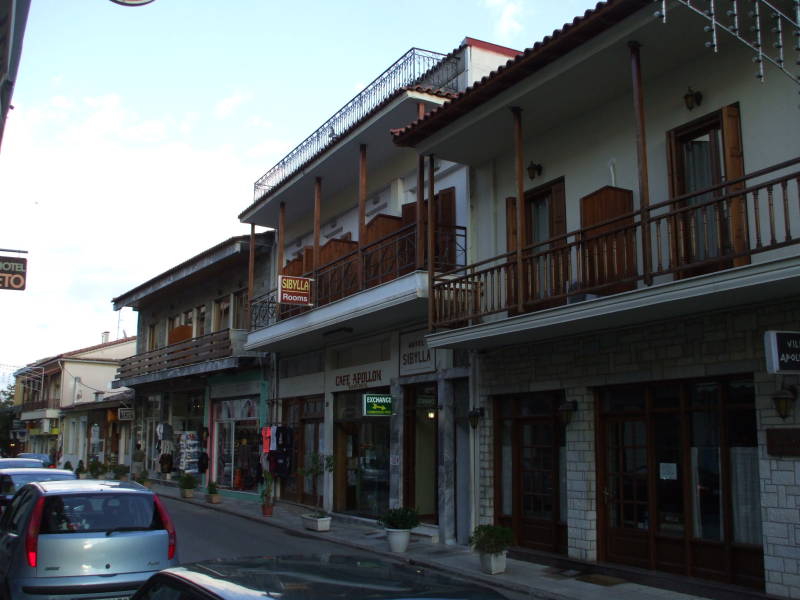
Sibylla Rooms is a nice place to stay in Delphi.
Sibylla Rooms is a nice place to stay in Delphi:
+30-22650-82335
sibylla-hotel.gr
Stay overnight, so you can visit the sites in the
early morning or late afternoon when they're not
overrun by large groups in a loud hurry.
The modern town has a population of about 2,400, and largely consists of small hotels and tavernas along two narrow parallel streets.
The road splits into two one-lane streets, each with traffic in one direction only. The tavernas on the downhill side of each street have great views down over the valley toward the port.
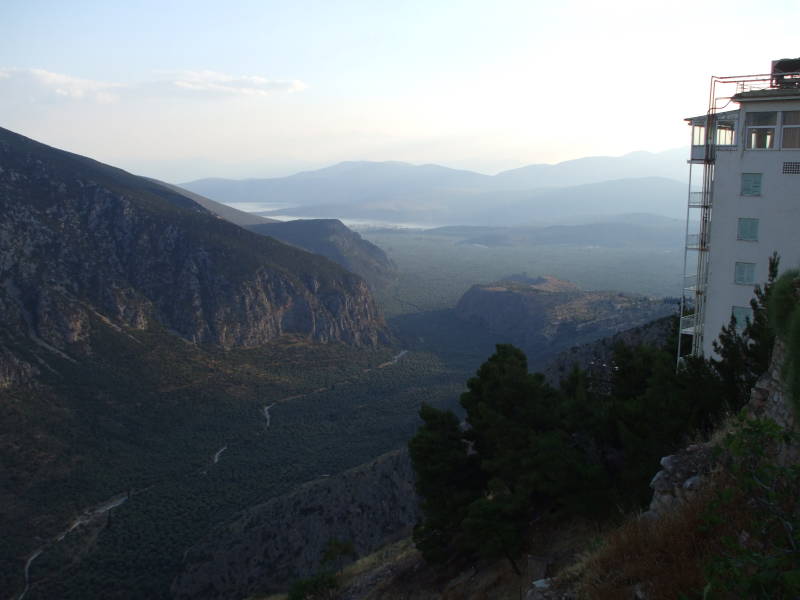
Late in the afternoon at Delphi.
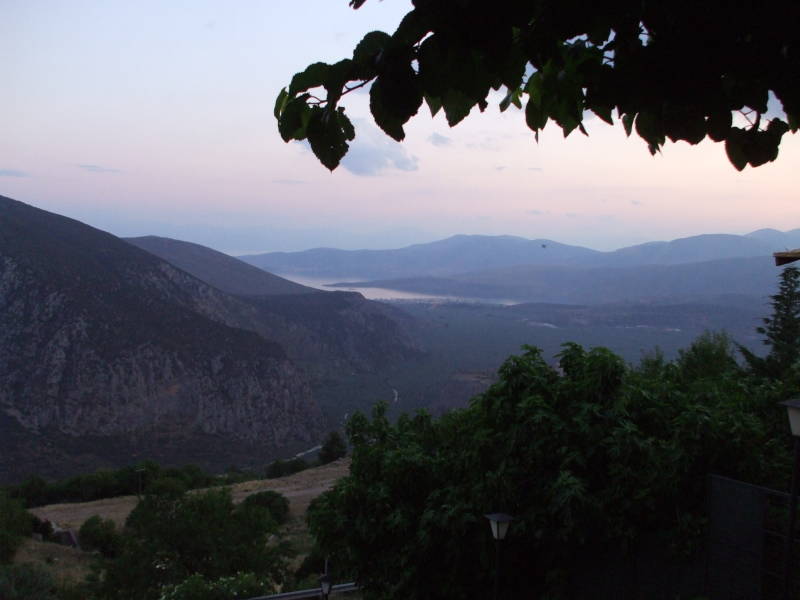
Evening falls at Delphi.
Stay overnight at Delphi, watching evening fall over the valley as you linger over dinner at a taverna.
Getting to Delphi takes about three hours by bus from Athens, or two hours from Lamia. For travel between Delphi and Meteora, you have to go by way of Larisa and a change of buses. The closest train station is in Livadia, 47 kilometers away.
